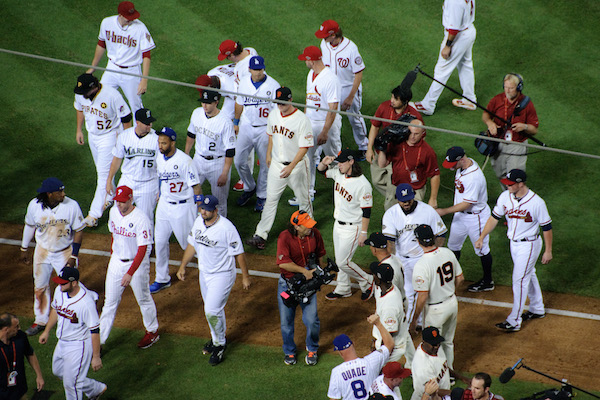Dear Sports Fan,
Why is it that in Major League Baseball, every team have to have at least one representative in the All-Star game? Other professional leagues, like the National Football League don’t require one representative from each team. Why does each team get a player in the MLB All-Star game?
Thanks,
Derek Blackman
Dear Derek,
All-star games are a funny reminder of the thin line between sports and entertainment. The difference lies in the competitive nature of the games. Take that away, as you do during most all-star games, and what you’re left with is purely entertainment, even if it still looks like sport. That’s one of the reasons why sports leagues are so concerned about any accusations of match-fixing or betting on games by players or managers. They understand what differentiates them from reality TV is true competition and how easily the perception of its truth can be undermined. An all-star game is a voluntary relaxation on the part of sports leagues. For a day or a weekend during the middle (or in one case, close to the end) of the season, the league takes a rest from competition and puts on a purely entertaining show.
Tickets to the show are expensive – this year’s MLB All-Star game has tickes on Stubhub ranging from just under $300 to over $4,000 – but it’s primarily a TV show. Baseball games are normally TV shows, each one attracting fans of the two teams involved as well as a smaller number of casual (or obsessed generalist baseball) fans but if the league is going to halt all their other shows for a single one, they better be sure it’s going to get the ratings (and therefore advertising dollars) to merit the break from normal games. Baseball has lots of tactics to make sure this happens. It packages the game (made less interesting by the lack of competition) with lots of novelty events (the Home Run Derby, primarily) that don’t happen at any other time during the year. They partner with strong television networks who will promote the game incessantly. Lone among the leagues, Major League Baseball gives their all-star game importance to the regular season. The league that wins the All-Star game (which is played between the American and National Leagues) ensures that its representative in the World Series (baseball’s championship which is also contested between the two leagues) has the opportunity to play four out of the seven possible World Series games at home. The fact which you mention in your question — that every MLB team is required to have at least one of their players on the All-Star team — is another important way of ensuring an audience. Representation from each team, regardless of how bad the team is, is meant to guarantee representation from each team’s fan base when it comes to watching the All-Star game. So far, it seems to be working. The MLB All-Star game does get much better ratings than an average baseball game. In the past few years, it’s averaged around a 7 rating (7% of all households that have a television were watching this) while regular season baseball games averaged only a .7. This means ten times more people watch the All-Star game than a normal game.
Major League Baseball is not alone in this approach to its all-star game. The National Hockey League (NHL) also requires one representative from each team and, although they experimented a few years ago with taking away that rule, they went right back to it. The NBA All-Star game does not work that way, in part simply because of numbers. With 30 teams and only 30 All-Star players, a requirement to have one player from each team would be obviously unfair to players and fans of extremely good teams and would lower the level of entertainment by excluding too many well-known stars. The way the NFL schedules their all-star game, called the Pro Bowl, precludes it from including everyone. Held one week before the Super Bowl, players from the two Super Bowl teams are excluded. Even setting those teams aside, the league allows some teams to be excluded. In 2014, for example, four teams had zero players selected to the Pro Bowl.
Major League Baseball’s approach to team representation in its all-star game makes sense if you view all-star games as purely entertaining TV shows. Many people feel that the logic begins to break if you view the All-Star game as competition – as sport. Normally players, coaches, and fans wouldn’t dream of viewing an all-star game this way, but by making the game decide home-field advantage in the World Series, baseball forces this interpretation to some extent. If the All-Star game is competition, then it follows that each team should be trying to win as hard as they can, even if this means excluding some teams entirely from the game. The argument against this line of thought is that there’s always a balance between entertainment and competition inherent in any televised sport. Surely it would be easier to win if you hid the other team’s cleats from them so they had to play barefoot but it wouldn’t make for as appealing entertainment (actually it would, but you can supply your own example). The All-Star game must get higher ratings than a normal game to justify its existence and a rule that requires representation from all 30 teams and fan bases helps make that happen.
Thanks for reading,
Ezra Fischer

